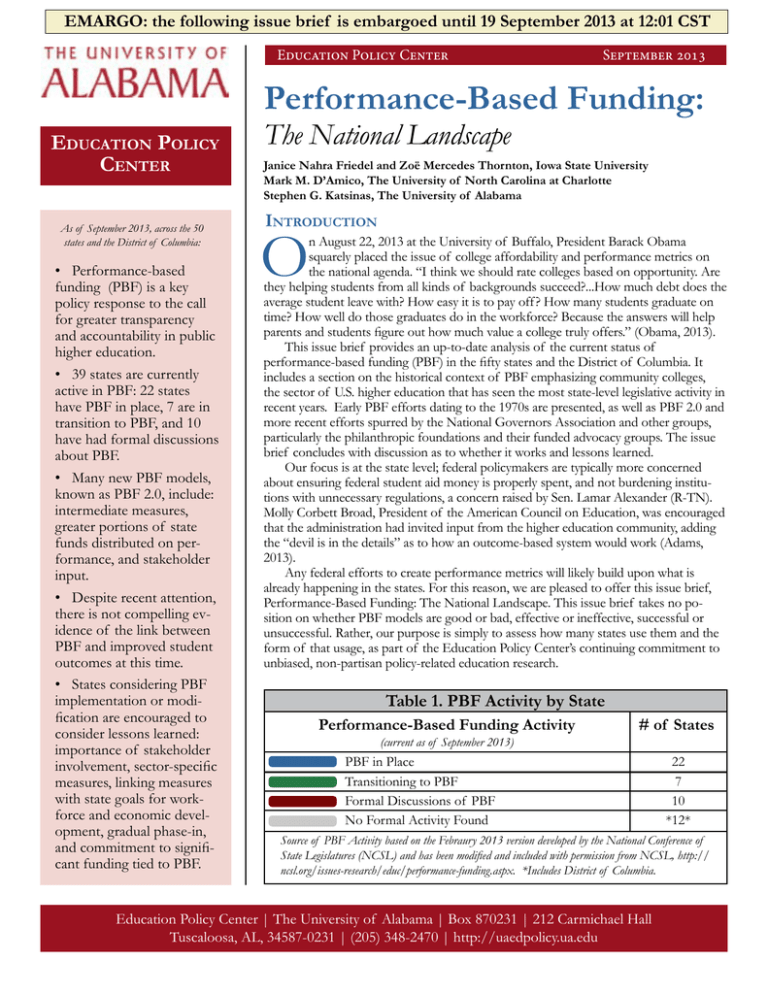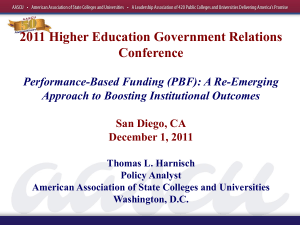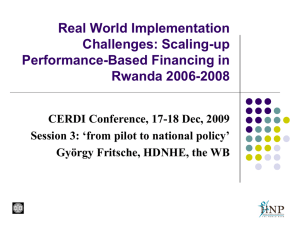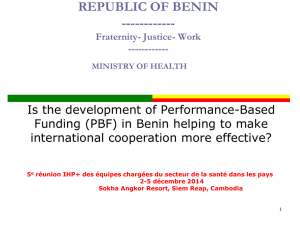Performance-Based Funding: The National Landscape E P
advertisement

EMARGO: the following issue brief is embargoed until 19 September 2013 at 12:01 CST Education Policy Center September 2013 Performance-Based Funding: EducatIon PolIcy cEntEr The National Landscape Janice Nahra Friedel and Zoë Mercedes Thornton, Iowa State University Mark M. D’Amico, The University of North Carolina at Charlotte Stephen G. Katsinas, The University of Alabama IntroductIon • Performance-based funding (PBF) is a key policy response to the call for greater transparency and accountability in public higher education. • 39 states are currently active in PBF: 22 states have PBF in place, 7 are in transition to PBF, and 10 have had formal discussions about PBF. • Many new PBF models, known as PBF 2.0, include: intermediate measures, greater portions of state funds distributed on performance, and stakeholder input. • Despite recent attention, there is not compelling evidence of the link between PBF and improved student outcomes at this time. • States considering PBF implementation or modiconsider lessons learned: importance of stakeholder measures, linking measures with state goals for workforce and economic development, gradual phase-in, cant funding tied to PBF. O n August 22, 2013 at the University of Buffalo, President Barack Obama squarely placed the issue of college affordability and performance metrics on the national agenda. “I think we should rate colleges based on opportunity. Are they helping students from all kinds of backgrounds succeed?...How much debt does the average student leave with? How easy it is to pay off? How many students graduate on time? How well do those graduates do in the workforce? Because the answers will help This issue brief provides an up-to-date analysis of the current status of includes a section on the historical context of PBF emphasizing community colleges, the sector of U.S. higher education that has seen the most state-level legislative activity in recent years. Early PBF efforts dating to the 1970s are presented, as well as PBF 2.0 and more recent efforts spurred by the National Governors Association and other groups, particularly the philanthropic foundations and their funded advocacy groups. The issue brief concludes with discussion as to whether it works and lessons learned. Our focus is at the state level; federal policymakers are typically more concerned about ensuring federal student aid money is properly spent, and not burdening institutions with unnecessary regulations, a concern raised by Sen. Lamar Alexander (R-TN). that the administration had invited input from the higher education community, adding 2013). Any federal efforts to create performance metrics will likely build upon what is already happening in the states. For this reason, we are pleased to offer this issue brief, Performance-Based Funding: The National Landscape. This issue brief takes no position on whether PBF models are good or bad, effective or ineffective, successful or unsuccessful. Rather, our purpose is simply to assess how many states use them and the unbiased, non-partisan policy-related education research. Table 1. PBF Activity by State Performance-Based Funding Activity # of States (current as of September 2013) PBF in Place Transitioning to PBF Formal Discussions of PBF No Formal Activity Found 22 7 10 *12* Source of PBF Activity based on the Febraury 2013 version developed by the National Conference of September 2013 Performance-Based Funding: The National Landscape In the twentieth century, the United States, attained global economic and political prominence. Today, this global ranking has been displaced, as the proportion of the U.S. population age 25-34 with an associate degree or higher has Increasing degree completion at America’s public colleges and universities is pivotal for the nation’s economic competitiveness and long-term economic growth. To meet this goal in a time of policymakers and higher education leaders need comprehensive, consistent performance metrics to shape funding strategies and pinpoint areas for improvement. – National Governors Asso ciation Work Group on College 2011) (See Figure 1 below). reclaiming our prominence in the global economy can only be accomplished with an educated and technologically savvy workforce. In a direct response to this critical need, President Obama (2009) announced his goal for the United States to have “the best educated, most competitive workforce in the include increasing the number of college gradu- ates, with all Americans completing at least one year of college. The college completion focus is both a workforce and an economic development issue and, as such, has shifted attention to postsecondary education. The 2020 goals are Initiative which includes measuring progress on loan repayment, student loan debt, and earnings potential (Kanter, 2012). The demand for higher college completion rates comes at a time when public colleges and universities are facing several issues in direct competition to their goals: state appropriations cuts, increasing numbers of atand Policy Analysis Team, 2013; Harnisch, 2011a; Mortenson, 2010). Many states have increased oversight of public higher education through accountability tures, 2013) even while resources allotted to the institutions have declined (National Governors Association and the National Association of Figure 1. Percentage of Adults Age 25–34 with Postsecondary Education Indicator A1: To what level have adults studied? Table A1.3a Population with tertiary education (2009) 2 Education Policy Center || The University of Alabama September 2013 method for measuring success and providing state funding to public colleges has relied primarily on enrollment thus ensuring a focus on accessibility; however, the enrollment-based model is limited and does not align with the current national agenda for increasing the number of college graduates. The challenge has now away from the costs of educational inputs toward stronger performance outputs, while still main- that institutions meet, the more funding they educational and workforce needs increases, PBF education offer a way to begin meeting this demand. What is PBF? Higher Education Department, 2011, p. 1). One option for state-level response to current national agendas is the introduction of performance-based funding models within Unlike performance-based budgeting which utilizes performance indicators, among other mance-based funding relies on a formula which utilizes performance indicators to decide actual funding amounts (Dougherty & Hong, 2005; by twenty-two states (with more transitioning to or involved in formal discussions) (See Figure 2), performance-based funding extends beyond enrollment to include incentives for productivity and completion (or transfer) (Har- of state allocations is awarded based on institutional outcomes. Thus, performance-based budgeting is indirectly tied to funding, while performance-based funding (PBF) is directly tied to funding as “a system based on allocating performance-based funding (PBF) “rewards institutions that meet state goals,…is based on outputs instead of inputs,…(and) the more goals (Miao, 2012, p. 1). Harnisch (2011a), referring to resource Figure 2: PBF State Activity Map (current as of September 2013) Note: The PBF State Activity Map is based on the February 2013 version develference of State Legislatures and included with permission. formance-funding.aspx. The current table includes updates by the authors from the state legislative websites, websites of state higher education agencies and governing boards, and community college state directors in attendance at the annual summer meeting Sky, MT. PBF in Place (22 states) Transitioning to PBF (7 states) Formal Discussions of PBF (10 states) No Formal Activity Found (12 states) Education Policy Center || The University of Alabama 3 September 2013 states that “leaders of public colleges and uniappropriations, …(and as such,) they will take the measures necessary to retain or enhance their toward improving performance through funding incentives (Harnisch, 2011a; Rabovsky, 2012). currently in use by states: output-based funding formula, performance set-asides, and performance contracts. cal incentives for positive improvement in specific metrics. This model is utilized within the state funding formula as a portion of the annual base appropriations. Often weighted for institutional mission, this model allows community colleges to increase their total appropriations through Performance set-asides reserve a percentage of the state funding to be awarded to high performing institutions. The set-aside dollars may be a portion of the annual base appropriation compete with each other for the set-aside funding by achieving a “A number of states, including targeted measure Tennessee, are taking innovative of performance set steps to reduce college costs by prior to the year. tying state aid to graduation rates Performance conand other measures. But Washing- tracts between the ton needs to be careful about taking individual commua good idea for one state and forc- nity college and the ing all 6,000 institutions of higher state provide a third education to do the exact same option for PBF thing, turning Washington into a models. Through sort of national school board for this model, funding our colleges and universities.” is awarded if the community college meets the agreed upon performance goals set forth in the contract (Miao, 2012). propriations (generally 1-25%), PBF is awarded based on the outcomes of certain performance 4 Education Policy Center || The University of Alabama toward both institutional mission and state goals (Harnisch, 2011a). As a results-based model, PBF considers success through outcomes (such as credit completion), as opposed to inputs (credindicators of at least two types: general outcomes and progress outcomes (Harnisch, 2011a; Miao, 2012). Depending on state priorities, subgroup outcome indicators and high-need subject outcome indicators may be included, as well (Harnisch, 2011a). Previous literature (Dougherty & Reddy, 2011; Harnisch, 2011a; Miao, 2012; education performance-based measures have evolved over time to include indicators such as: Figure 3: Types of Performance Indicators: General outcome indicators: gradresearch or grant funding awarded, job placement rates, student success on licensing exams; Progress outcome indicators: numter credits, developmental course completion, number of students who transfer to a four-year institution after completing 12 credits, dual enrollment credit completion; Subgroup outcome indicators: low-income status, at-risk status, Pell Grant recipients, High-need subject outcome indicators: performance-based measures have moved beyond enrollment and graduation to include transfer, developmental education, and STEM-related coursework. Additionally, the formulas may be weighted for marginalized populations, including low-income, adult, and at-risk students. By assigning a weight to certain indica- September 2013 NGA Complete to Compete: particular indicators. For instance, most states provide additional weight for the progress and completion of low-income students within the PBF formula, recognizing the additional barriers these students face when seeking degrees. Weighting certain indicators in the PBF formula is also useful for recognizing the unique features of institutional mission (Miao, 2012). Contextual Considerations for Community Colleges Policymakers and other stakeholders are increasingly calling for greater transparency and accountability in higher education (Trettel & Yeager, 2011). Both the Lumina Foundation have national goals and initiatives addressing college student success, persistence, and completion. The 2009 strategic plan of the Lumina Foundation has the goal of increasing the percentage of Americans who hold high quality degrees and credentials to 60% by 2025 (Kelderman, Graduation Initiative calls for 5 million additional college graduates by 2020 (Kanter, 2012). and progress metrics to be measured and compared across the states. These metrics include degrees awarded, graduation and transfer rates, enrollment and success in developmental education, retention rates, credits earned, and time and credits to degree (Reyna, 2010). In direct alignment of this national agenda, the state-level PBF model rewards community colleges for improving progression toward completion. In a recent report from the 21st - Common College Completion Metrics Outcome Metrics The outcome metrics quantify the end-product of the educational process, informing policymakers and the public on how students, institutions, and the state are performing on the goal of increased postsecondary attainment. Degrees Awarded Graduation Rates Transfer Rates Time and Credits to Degree Progress Metrics Progress metrics measure student movement from semester-to-semester and year-to-year toward the completion of an academic program. Such measures es and opportunities for improvement in higher education. Enrollment in Remediation Education Success in Remedial Education Success in First Year College Courses Credit Accumulation Retention Rates Course Completion by funding formulas “that encourage enrollment growth…without adequately supporting that growth, and largely without incentives for proEducation Policy Center || The University of Alabama 5 September 2013 community colleges to the needs of the 21st tury, including a shift in focus from access to one on access and success, as well as enhancing decision-making through a culture of evidence. to be cut during budget crunches (Dougherty to enrollment, institutional performance, and funding attached, many PBF 1.0 models failed to incentivize change for institutions. Many of the As community college appropriations are declining (or frozen) in many states and tuition continues to rise, PBF policies can provide an opportunity to tie outcomes to funding. By lapse (Miao, 2012). What is PBF 2.0? education, legislators may become more committed to avoiding cuts to community college appropriations during tight budget years. This may provide the colleges a greater level of trust in the legislative appropriations process, and greater control over the potential amount of funding received. performance-based funding, a renewed interest PBF: Historical Perspective duced to higher education as a funding initiative option quickly spread across the nation, with 26 states utilizing PBF policies at some point by mid-2000 (Harnisch, 2011a; Rabovsky, 2012). Many of these early policies were attached to state budgets began to be cut, PBF was often nisch, 2011a). - What went wrong with early PBF models? Although PBF models have been in use since of current models (often referred to as PBF 2.0) from the early models (now referred to as PBF phasized outcomes measures such as completion and transfer, with only minor attention to progress measures, such as retention. Often designed without input from higher education leaders, 6 1.0 models frequently disregarded institutional goals and mission, and emphasized completion over progression (Dougherty & Reddy, 2011; Miao, 2012). Instead of being a percentage of the base appropriations, PBF 1.0 funding was Education Policy Center || The University of Alabama tying institutional performance to state appropriations. Seeking to improve upon past models, lawmakers of several states have put forth efforts to research PBF and create updated models to meet the current educational and workforce needs of the state (Harnisch, 2011b). Often referred to as PBF 2.0, these newer versions seek to improve upon the negative mance at the state level. One key failure of past models was the exclusion of the stakeholders in the planning phases, particularly community college leadership. Thus, an important characteristic of the 2.0 model is a joint planning process by which policymakers and other constituents agenda for higher education, while providing alignment with institutional priorities (Blankenberger, 2011; Miao, 2012; Shulock, 2011). A key component of current PBF 2.0 modhigher education. Thus, the state and the community college partner to achieve an improved Included in the 2.0 model is the acknowledgment of individual institutional mission (Blankenbergbut instead to incentivize progress toward those components of the institutional mission that September 2013 “A core principal of is that funding formulas must be systematically aligned with the goals and priorities of the state in order for colleges and universities to have the incentives and resources they need to achieve the targets set for them.” –Eric Chancellor of University Sys and needs (Harnisch, 2011a). Another component of several PBF 2.0 policies addresses the implementation of the plan, often allowing the indicators are measured and the state provides feedback on the outcomes (Dougherty, Natow, Hare, & Vega, 2010; Miao, 2012). There is no actual funding attached to the indicators er Education Finance Study er the PBF plan includes a Commission. colleges through enhanced incentives for serving atrisk, under-prepared, and other marginalized populations through weighted formulas (Blankenberger, 2011; Miao, 2012; Shulock, 2011). Encouraging performance improvement over time within a community college, instead between colleges, increases gaps (Shulock, 2011). - ual implementation allows institutions to adjust their data collection and reporting processes accordingly and prevents any major funding losses. Some states also include a stop gap, also prevents major funding losses or colleges falling too far behind in the process (Miao, 2012; Shulock, 2011). We refer to the combination of transition While previous PBF plans (1.0 models) often limited performance measures to ultimate outputs (graduation or transfer rates), PBF 2.0 models include intermediate measures as well (Blankenberger, 2011; Miao, 2012; Shulock, 2011). These include developmental education completion, progress indicators (such as completion of 12 and 24 credits), and retention indicators (such as fall to spring or fall to fall enrollment). Additionally, PBF 2.0 aims to ensure the continued access and equity of community “States must increase the number of high-quality college graduates within available funding to meet workforce needs and compete globally. To meet the goal, policymakers- including governors and higher education leaders need comprehensive and consistent performance metrics for public campuses and systems to inform policy decisions and pinpoint areas for improvement.” ly, the percentage to be appropriated, what dollars will be used (new or established) and whether the funding will be in addition to or a portion of the annual base appropriations. While earlier versions of appropriations, newer versions utilize a percentage Reddy, 2011). Which States use PBF Today? When examining the status of PBF model implementation across the states, one concludes that the status report given in Table 2 is noted to be “a their PBF to the PBF 2.0 model; others are movhaving learned from the lessons from other states are incorporating elements of PBF 2.0. Using the conducted a review of state legislative and higher education agencies and governing board websites, searching for updates and new developments. A draft of an updated PBF State Activity Table was circulated at the 2013 annual summer meeting of the authors made every attempt to accurately list sec- some states have measures for universities, others for community colleges, and others for both sectors. Based on these various sources, as of September 2013, we conclude that 39 states are active in –NGA Work Group on College Completion Metrics PBF: 22 states currently have funding formulas in place which directly relate some portion of the state Education Policy Center || The University of Alabama 7 September 2013 appropriations to institutional performance: Arizona, Arkansas, Illinois, Indiana, Louisiana, Massachusetts, Michigan, Minnesota, Mississippi, Missouri, Nevada, New Mexico, North Dakota, Ohio, Oklahoma, Pennsylvania, South Dakota, Tennessee, Texas, Utah, Virginia, and Washington. Seven states are transitioning to PBF described below, Tennessee, Washington, and Ohio. These states were chosen for discussion due to their history with PBF, the evolution of the model in their state, and the lessons learned from their implementation with PBF. colleges report on slightly different performance indicators. The university indicators include credit accumulation, degree completion, research and grant funding, transfers out, and six-year graduation rate. The community college indicators include credit accumulation, dual enrolled students, degree completion, job placement, developmental education progression, transfers out, and workforce training (Dougherty & Reddy, al and low-income students are more heavily Tennessee With 100% of state appropriations soon to be more states are currently in formal discussions gia, Idaho, Kentucky, Maine, Maryland, New - - (Harnisch, 2011a), Tennessee has the longest running record of PBF efforts but has also revised its model eight times (Sanford & Hunter, 2011). Prior to 2010, PBF held for only a small portion of the total state appropriations (ranging from 2%-5.45% of the base), while the bulk of the funding continued to be allocated on institutional enrollment (Dougherty & Reddy, retention and graduation rates, Sanford and Hunter (2011) found that PBF did not result in improved outcomes at the public four-year universities; additionally, they found that increasing the funds tied to performance from 2% to 5% did not result in any further improvements in performance. In a separate study of PBF in slight uptick in graduation rates in the two- and four-year higher education institutions. These results may have led legislators to recognize as Miao (2012) did that PBF amounts must be proved outcomes. Tennessee has recently taken a bold step towards a complete outcome-based system, foregoing enrollment as a measurement for funding altogether. 8 example of the 2.0 model through the use of stakeholder collaboration, institutional mission acknowledgment, alignment with state priorities, measuring progress and completion, and the use of stable funding through base appropriations. Utilizing separate formulas to recognize differing Education Policy Center || The University of Alabama strategies to improve retention and completion, including additional advisors, increased tutoring and developmental courses, and fast-track courses and programs (Harnisch, 2011a). Washington After a short three-year stint, Washington groups of indicators for the universities and the community colleges, and awarded a small percentage of the base state appropriations that was held back and reassigned as PBF (Dougherty & Reddy, 2011). and 2.0 model practices for a performance setnisch, 2011a) under the Student Achievement Initiative established in 2007 by the State Board erty & Reddy, 2011). Utilizing new money, the system incentivizes certain outcomes by awarding additional funding “based on their accumulation These are earned through several indicators, September 2013 including basic skills and developmental education, credit accumulation, college-level math course completion, apprenticeship training, and degree and the system was a learning year, which allowed the community colleges the opportunity to examine funding (Dougherty & Reddy, 2011). Although Washington uses a bonus funding model (1.0), the state has incorporated 2.0 model practices with the measurement of both progress and completion, as well as the learning year during the initial stage. Since its establishment in 2007, this PBF model appears to have increased performance in each of the indicator categories (Harnisch, 2011a). Ohio Ohio introduced separate 1.0 PBF models for the public universities and community colleges in 1995, each of which awarded a small bonus for transfer and completion rates. Beginning in 2010, state legislation began phasing in a new system for PBF by incorporating 2.0 model practices, effectively ending enrollment-based funding for the uniThe current university PBF model awards 100% of the state appropriations based on course and degree completion, with the degree component being phased in over the course of several years. This funding is weighted for the cost of programs and low-income students (Albright, 2009; Dougherty & Reddy, 2011). Beginning in 2011, community colleges received up to 5% of their state appropriations through the new PBF model; this amount is gradually being increased each year to 30% of the & Reddy, 2011). The community college performance indicators include progression through a sequence of developmental coursework to college credit coursework, accumulation of credits, degree completion, and transfers to four-year institutions. Both PBF models include a stop-loss provision to prevent any institution losing more than 1% of their base funding, however this will eventually be Does PBF Work? Although PBF models have been utilized in some form for the past 30 years, there are mixed reviews on their success. While little research has been completed on the overall effects of current PBF models, there have been several observations 2011). These early results (Dougherty & Reddy, to the individual student, the college, and the state, including: Increased awareness and alignment of the instiexpectations; Increased college self-awareness of actual outcomes (both intermediate and ultimate); Increased healthy competition between colleges based on publication of outcome measures; Increased use of data during institutional planning and decision making. Disadvantages of PBF models include the possibility that the chosen indicators measure only a portion of the entire institutional picture, and that the potential exists for negative effects on institutional quality, access, equity, mission, or stability PBF proposal to fund community colleges based on course completion and noted their concern that the course rigor, recommending instead the development of a model that balances both access and success (LAO, 2013). Additionally, college and university leaders in Texas have expressed concern that PBF models may cause an additional loss of funds, While PBF 2.0 considers improvement within intermediate outcomes, the ultimate goal of this funding model is to increase the number of college workforce needs within the state. However, the Education Policy Center || The University of Alabama 9 September 2013 and economic development priorities (Harnisch, there will be little direct impact on the ultimate desired outcome of increased graduation rates (Rabovsky, 2012). Lessons Learned Several points are important for consideration when designing PBF models for higher education: the relationship between PBF and strategic planning for institutional and state-level futures, the importance of the use of benchmarks, the involvement of stakeholders in development, and - incentivize institutions (Miao, 2012). The lessons learned from early PBF1.0 models will impact the design and success of the 2.0 model, as well as help alleviate concerns of colleges and universities. with PBF appear supportive of the system (Dougherty et al, 2010); however, this may be attributed to their need for additional state funding and acceptance of processes for new funding proponents of PBF options (Dougherty et al., will ensure their unique perspective and needs are represented in the model, and that the chosen improvement (Harnisch, 2011a; Miao, 2012; Shulock, 2011). An important factor in planning and designing the PBF system includes input from the various stakeholders (Dougherty et al., 2010; Har2011). The design process should involve policymakers, higher education leaders, faculty, business leaders, education organizations and others who may have a vested interest in higher education proequity and access to higher education, Dougherty et al. (2010) also suggest the inclusion of minority and social-equality groups during the planning process. Extremely important is the alignment of the guidance on the vision of the state and its workforce and economic development needs, public higher education cannot truly serve as a tool for the state to advance on its goals. Successful PBF models measure performance indicators related to the goals of the institution, which in turn support ck, 2011). Blankenberger (2011) notes that at the core of its purpose, PBF “rewards institutions that Institutional mission and characteristics should be taken into account within the PBF model (Har2011). Utilizing different performance measures PBF from hindering or altering the mission, access or equity of a college or university. In particular, community colleges and four-year universities have distinctly different missions and goals. PBF formulas and the indicators selected to measure performance and improvement must accurately represent each institutional type. Additionally, the funding formula should reward institutional improvement, rather than only the top achievers and avoid statewide competition for funding (Blankenberger, 2011; Shulock, 2011). Simple and clear performance indicators measuring access, progression, and completion should be utilized within the PBF model to ensure clarity and understanding of the expectations (Harnisch, the PBF formula should include weighting for marginalized populations by providing incentives for progression and completion by academically continued access and equity (Blankenberger, 2011; component of current, successful PBF models is the inclusion of both progression (retention) and completion indicators. Very important to the success of PBF systems is the commitment of stable funding streams, with change (Harnisch, 2011a; Miao, 2012; Rabovsky, 10 Education Policy Center || The University of Alabama September 2013 the effectiveness of PBF policies on institutionto these policies (Rabovsky, 2012). Referring to the casual logic of PBF, Rabovsky (2012) examined whether institutions responded to funding incentives with new spending practices aimed at improving retention and completion. Interestingly, Rabovsky (2012) noted that the minimal level of in fact, be attributed to the small percentage of state appropriations most PBF models currently utilize. There exists “the potential for these policies to have considerable effects on administrative behavior if policymakers could more effectively (Rabovsky, 2012, p. 694). As such, state funding dollars designated as PBF provide an incentive for improvement when they are provided as additional funds, beyond the yearly appropriation. Additionally, these funds should be solid, with a low risk of being reduced or removed in future years. The threat of impending reduction only serves to elicit distrust from the colleges and universities and hinders the intentions of measuring and encouraging increased effectiveness. A great concern of institutions facing new PBF systems is the possibility of dramatic losses of funding during the initial years. This concern can be put at ease by gradually phasing in the new system over a few years and by incorporating a stop-loss gap provision (Miao, 2012; Shurlock, assurance that funding will not drop below a certain percentage can provide some positive light on the new PBF system. Additionally, by utilizing the the opportunity to examine their actual performance outcomes and begin making changes before funding is at stake (Harnisch, 2011a; Miao, 2012). Finally, the PBF system should be continuously evaluated for success and improvement (Harnisch, the continuous improvement of particular measures, causing the need to modify or change the use of those indicators within the formula. Simi- larly, an institution may begin adapting its practices to meet performance requirements, while inadvertently creating negative effects on students. These are both examples of the need for continuous monitoring and evaluation of PBF systems, as well Conclusion The prevalence of performance-based funding models has increased recently, in conjunction with the national college completion agenda and the unfortunate decline in state appropriations. It is important to note that PBF is not the answer to the larger issue of declining support and funding for higher education, and thus should not be used to meet the greater funding issues of higher education. While there is not compelling evidence of the link between PBF and improved student outcomes at this time, we recomend that states at least consider the following: Figure 4. Policy Recommendations 1. Engage stakeholders in the discussion and planning, including legislators, college leaders and business and industry representatives; 2. Align the measures of the PBF model with state goals, particularly workforce and economic development goals; 3. Allow for the differentiation of institutional missions; 4. Plan to phase in the new PBF model and year); 5. the PBF system; 6. Include both outcome and progress performance measures; 7. As an alternative to incremental increases in enrollment-driven funding, a PBF model provides an opportunity for increased accountability for ensuring quality and meeting state needs. State legislators considering PBF are advised to study its limitations, advantages and disadvantages, and to consider the lessons learned from the states that have implemented PBF. Education Policy Center || The University of Alabama 11 September 2013 References cy Analysis Team. (2013). Top 10 higher education state policy is sues for 2013. American Association of State Ad ministration’s College Affordability Week. ministrations_college_affordability_ideas_triggers_range_ of_reaction.html Albright, B. N. (2009). education performance funding 2.0 tip sheet. Lumina Foundation for Education. Alexander, L. (2013, August 22). Alexander Statement on the Performance incentives and public college accountability in the United States: A quarter century policy audit. - Presidents of Texas universities warn against tying funds to graduation rates. . Retrieved from www.dallasnews.com - (2013, February 11). Should community colleges be paid only for students who complete courses? Retrieved from should-community-collegesbe-paid-only-for-students- policymakers (An Achieving the Dream policy brief). Boston, d7c77b412709 Harnisch, T. L. (2011a). Perfor ing strategy in public higher . Washington, 22(2), 9-30. (2005). State systems of perfor mance accountability for community - No. 47). New York, NY: Harnisch, T. L. (2011b). Perfor institutional outcomes. Presented at the 2011 Higher Education Government Relations December 2011. Kanter, M. (2012, April 12). An America built to last (PowerPoint). Remarks of the Undersecretary for Postsecondary Education to the National A report from the 21 mission on the future of community colleges. st turyReport Blankenberger, B. (2011). Perfor - education institutions in the state of Presented at the Illinois Association of Institutional ber 2011. 12 (2011). The impacts of state performance funding systems on policy recommendations Working Paper No. 37). Re- - 2012 meeting, Orlando, Fl. ary 13). Lumina Foundation adopts new tactics to reach college-completion goal. Retrieved from - (2010). The political origins of higher education performance Education Policy Center || The University of Alabama February 12). The 13-14 Budget: Analysis of the Higher Education Budget. Sacramen- September 2013 Performance-based budgeting requirements in 47 out of 50. (1), 66-73. Miao, K. (2012). Remarks by the President on the Macomb Community College, of the Press Secretary. Redent-on-the-American-Graduation-Initiative-in-Warren-MI Obama, B. (2013, August 22). Remarks by the President on detailed look at best practices in 6 states - performance-based-fundMortenson, T. G. (2010). Trends education by parental income Postsecondary (No. 211). Oskaloosa, IA: Postsecondary Education OPPORTUNITY. Performance funding for higher edu cation. aspx National Governors Association and the National Association (2012). tions. - remarks-president-college-affordability-buffalo-ny Education at a concerns (Institute for Higher Education Leadership & Policy Brief). Sacramento, ty-Sacramento. - (2011). Linking strategic planning, priorities, resource allocation, and assessment. In S. E. Sutin, D. Derrico, R. L. Palgrave Macmillan. Washington Higher EducaPerfor (Policy brief). Olympia, WA: Author. spective. New York, NY: Harper and Row. Rabovsky, T. M. (2012). Accountability in higher education: Exploring impacts on state budgets and institutional spending patterns. Journal of Public Administration Re 22, 675-700. Reyna, R. (2010). Complete to New Mexico Higher Education Department. (2011). The Wat . Retrieved mance-funding.aspx Secretary. Impact of performance-funding on retention and graduation rates. Education Policy (33), 1-30. Shulock, N. (2011). Concerns about tion metrics National Governors AssociaRetrieved from www.nga. - Education Policy Center || The University of Alabama 13 September 2013 Table 2. State Activity Details on Performance Funding for Higher Education (current as of September 2013) State Alabama Arizona Arkansas Status Amount of PBF In transition 15% in FY2014 (enacted through regulation, not statute, by the Alabama State Board of Education) In place FY2013: $5 million of existing dollars expected to be reallocated 2012 SB 1530 by the Board of Regents based on performance metrics In place 2011 Act 1203 Begins with 5% in 2013-2014 school year, and increases in 5% increments until capped at 25% Metrics With encouragement from legislative leaders and the governor, the Alabama Department of Postsecondary Education commissioned a study to propose a new funding formula to allocate state appropriations. This will be implemented in the 2014 Fiscal Year, which in Alabama starts on October 1, 2013 Public universities: • • • • Degree completion Research and public service funding Separate, yet similar formulas for community colleges and universities: 40% of performance funding: • Total credentials awarded • Bachelor credentials awarded • STEM production • Student progression 60% of performance funding: • Optional measures selected by each institution Legislators are currently in discussion and have recommended a working group to design performance metrics to include: Formal discussions 2013 SB 195 In transition 2011 SB 52 14 Florida In transition Georgia Formal discussions • • • • • • • • • Begins no earlier than FY 20162017; 25% of the General Fund appropriation that exceeds $650 million in total higher education operating appropriations; performance funding implemented only when total state higher education General Fund appropriations reach at least $706 million Education Policy Center || The University of Alabama Graduation rates Transfer rates Degree completion Low-income degree completion Developmental education Retention rates Degree completion in relation to state needs The metrics are still under development with the following goals: • • • • Increase attainment Improve student success Diversify enrollment and reduce attainment gaps Restore balance in postsecondary revenues and maintain productivity The metrics are under development with the goals of increasing graduation and employment rates in targeted program areas, and increasing the number September 2013 Idaho Illinois Formal discussions In place 2011 HB 1503 Indiana In place Ed Budget Reccommend. for 2013-15 Kentucky Louisiana Less than 1% in FY2013; may grow in future years Public universities: • • • is based more on enrollment 5% in FY2011-FY2013; projected Institutions evaluated against the same benchmarks to be 6% in FY2014 and 7% in regardless of size or mission: FY2015 • Overall degree attainment Formal discussions In place 15% of total state budget 2010 GRAD Act allocation • • • • • • On-time degree attainment Low-income degree attainment • Graduation rate and graduation productivity goals consistent with institutional peers Program completion Partnerships with high schools to prepare students for postsecondary education • • • Maine Maryland Massachusetts Formal discussions Formal discussions In place In place 2012 HB 5372 Dual-credit completion University research improvement exams and workforce foundational skills performance funding metrics and strategy funding with Maryland legislators and legislative staff in 2011 and 2012 $7.5 million in FY2014 ($5 million for community colleges, $2.5 million for public universities) Michigan Degree completion Amount of money spent on each degree Bonuses for low-income and minority students, and for STEM degrees 3% under FY 2012-2013 • • • Student learning • Workforce alignment • Preparing citizens • • Public universities: community colleges) • • Graduation rates Number of degrees awarded in STEM and • • Research and development expenditures Includes an incentive for universities to not increase tuition by more than four percent To be eligible for performance funding, • student transfer network, have reverse transfer agreements in place with at least three community colleges, and accept dual enrollment credits Education Policy Center || The University of Alabama 15 September 2013 Michigan (continued) Minnesota In place • • • • • Across the board improvement (50%) Degree completion (17.5%) Local strategic value (15%) • Graduation rate or degrees, diplomas & Administrative costs (7.5%) 5% of total appropriations 2013 SF 1236 • • • Mississippi In place As of FY2014, 100% of public university appropriations based on performance; a stop-loss is transition Missouri In place Report Approximately 2-3% (to be in place by FY2014) Persistence and completion rate Related employment rate Reduce student expenses through the use of Open Educational Resources (OER) tools and services • Reallocation of funds from expense realignment Public universities: • Retention rate • Undergraduate graduation rate • Diversity of faculty • • Expenditures Metrics vary by institutional sector and focus on the following areas: • • • • Montana Nevada In transition In place 2013 AB 507 An additional 5% ($7.5 million) on top of the total general fund appropriation available in 20142015 academic year 5% of base appropriations in FY2015 (FY2013 performance); for performance funding pool for FY2014-2015 16 Education Policy Center || The University of Alabama rates; (b) retention rates; (c) completion of (d) credit accumulation Degree attainment: (a) total degrees awarded; (b) graduation rates education E&G spending on core mission; (b) revenue growth per FTE student; (c) completed credit hours per $100,000 of state appropriations or E&G spending Metrics for the initial pilot year will include: • Annual number of undergraduate degrees and • Percentage of 1st-time, full-time freshmen returning for a second year of enrollment Long-range plans for future potential allocations would include mission differentiation • • • Transfer Increased success with underserved populations September 2013 New Mexico In place 5% Public universities: • • Brief • New York Formal discussions In transition SL 2012-142 in state workforce priority areas The State University of New York is leading a task force on developing recommendations General Fund appropriations; additional funds as available for exceeding performance on all eight measures; measurement in FY2013 and funding in FY2014 • • Basic Skills Student Progress Developmental Student Success Rate in • • • • First Year Progression GED Diploma Passing Rate Developmental Student Success Rate in • • North Dakota In place 2013 SB 2200 Ohio In place Moving from enrollment-based model; in FY2013, general fund appropriations will be based on credits completed; additional $5 million available through TBD performance measures Universities: all instructional funding on course completions instead of enrollments; degree completions being phased in (began in 2010) • • At-risk students are more heavily weighted in formula, and there is a STEM course incentive Public universities: • • funding based on Success Points; 95% based on FTE enrollment (began in 2011) Oklahoma In place Revised Funding Formula Oregon In transition HB 3120 Small percentage of the overall budget for higher education; in state workforce needs • • • • • • averaged $2.2 million a year; • Board of Regents in April 2012 • approved revised and expanded • funding formula for new dollars • or any funding the system receives • beyond its current base Progression from remedial to college level courses Students earning 15 and 30 college level credits Students earning an associate degree year institutions Retention rates Pell Grant retention rates 24-credit-hour completion rate Graduation rate Program accreditation will move under the governance of the Higher outcomes-based formula is under development for all sectors of public higher education. Education Policy Center || The University of Alabama 17 September 2013 Pennsylvania In place 2.4% Allocation Formula Formal discussions S 0266 (20132014) South Dakota In place To begin FY2016, annual appropriations will be distributed through an accountability-based period will be incorporated. $6 million Senate Bill 5 Public universities: Mandatory • Student success: degrees conferred and closing achievement gap • Access: close access gap and faculty diversity • Stewardship: private support dollars raised Optional (choose any 5 metrics from the following categories) • Success: deep learning scale results, senior survey, student persistence, value added, and STEM degrees • Access: faculty career advancement, employment diversity, student experience with diversity, and student diversity • Stewardship: facilities investment, admin. expenditures as a % of educational costs, faculty productivity, and employee productivity • indicators Metrics for public universities are under development, to include: • • • • Affordability and access Educational quality Economic development and institutional mission After a one-time performance funding pilot for public universities based on three years of degree production data, with more funding for producing provides the framework for performance funding Tennessee In place TN Act of 2010 18 100% Education Policy Goals, Performance, and Accountability Public universities: • • • • • • Education Policy Center || The University of Alabama Transfers out with 12 hours Degrees per 100 full-time equivalent (FTE) Six-year graduation rate September 2013 Tennessee (continued) Texas In place In place In place Virginia Higher Education Opportunity Act of 2011 Washington In place Student Achievement Initiative • • • • • Graduates placed in jobs Remedial and development success Transfers out with 12 credit hours Workforce training (contact hours) Award per 100 FTEs • • • • • Developmental education Gateway courses Transfers to a four-year Institution as a basis for higher education appropriations in Utah instead of funding institutions based solely on enrollment growth; mission-based funding will consider both enrollment growth and the strategic priorities for colleges and universities. As appropriations are available, community colleges and public universities submit proposals for high impact initiatives to be reviewed and approved by the Board of Regents. Accountability reports demonstrate the impact of the funded initiatives. Public universities and community colleges: 2011 Senate Bill 97 Virginia Student accumulating: 12, 24, and 36 hours Dual enrolled students 10% 2013 SB 1 Utah • • • • • • • • • Increased enrollment Increased degree completion Improved retention and graduation rates Increased research output • • • • Year-round use of campus facilities Online courses Resource sharing Better use of technology 2013-2015: approved • $10.5 million GED or H.S. diploma, and passing pre-college writing or math • • • First-year retention: earning 15 and 30 college level credits required for technical or academic associate degrees and apprenticeship training Education Policy Center || The University of Alabama 19 September 2013 West Virginia Wisconsin Wyoming Formal discussions Formal discussions In transition 2015-16: 2009 HB 114 $14.3 million Self-study has been completed; performance metrics are now being established, likely to include: • • Time to degree • Remedial education Note: The PBF State Activity Table is based on the February 2013 version developed by the National Conference of State About the Education Policy Center at The University of Alabama plishes its work through a dynamic research and policy agenda that, through active dissemination, seeks to inform and improve policy-making and practice at the national, state and local levels. Our coordinated program of basic and applied research deploys our extensive background in historical and topical analyses stitutions. Associate director Wayne Urban is a historian of U.S. elementary and secondary education, who Superintendents Academy, which provides professional development to create a broader pool of diverse . 20 Education Policy Center || The University of Alabama







